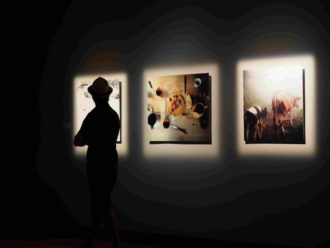Setting up an art exhibition
- Select a theme
- Recruit artists to exhibit
- Convey exhibition terms to artists
- Choose the work to exhibit
- Choose live or online
- Have an opening however you can
Setting up an art exhibition is always an administrative and logistical challenge, but at least in normal times you get to relax with some wine while hosting an opening party at your gallery. The traditional exhibit opening night may not be doable just yet, but exhibitions are as important to maintaining a vibrant gallery as ever.
Art galleries play a vital role in introducing new art and artists to the public, even while many of us are still hunkering in our homes. Restrictions on travel have left many people with unspent vacation budgets they could spend on art. Now is a good time to set up an art exhibition, whether for visitors to your gallery if health regulations permit or online if they don’t.
Setting up an art exhibition involves many separate but related tasks that require creativity, people skills, and good organization.
Pro Tip
Collect attendee registrations, artist applications, and more from any device with free online forms.
Select a theme
A theme distinguishes an art exhibition from a random collection of art works. The theme you select will guide artists in their submissions and play a central role in your marketing.
Themes set the ambience for the exhibition, prepare visitors for what they will see, and catch the attention of both visitors of and sponsors for the exhibition. Your theme can suggest the genre of art you will exhibit, such as portraits or landscapes.
An exhibition with a theme is more memorable for visitors — and it’s more likely to attract publicity that’s crucial to driving attendance and attracting artists interested in exhibiting their work.
A big bonus for gallery owners is that a themed exhibition can become an annual event that gains momentum every year as both visitors and artists look forward to the next exhibition.
Recruit artists to exhibit
Getting the artists you want to exhibit and discovering new artists to introduce at your exhibition is part networking and part marketing.
As a gallery owner, you’re probably well traveled in art circles in your community. Spread the word that you’re planning an art exhibit on a particular theme. Personally invite the artists you really want to participate — before you issue a public invitation for artists to submit work for exhibition.
That ancient “starving artist’’ cliche has persisted throughout history because it’s often true. Art is a calling to create and not generally a path to prosperity, so you can expect a lot of responses when you open your exhibition for submissions.
Managing all the submissions can be a headache, but using the Jotform template for art submissions simplifies the process. The template, which you can customize, keeps the name and contact information of the artist as well as images of the works they’re offering for submission conveniently online.
Avenue 12 Gallery in San Francisco is among the notable galleries that have used Jotform templates to simplify the logistics of organizing an art exhibition.
Convey exhibition terms to artists
Art is both a respite from the world of getting and spending and a business. Gallery owners and artists both need to earn a living, so tell artists up front all the details they need to know to decide whether to submit work for exhibition.
Important points to reveal from the start include what medium you want to exhibit, the commission you’ll take on any sales, how to submit work for consideration, and who is responsible for delivering works to exhibit and returning unsold artwork. Thinking through the details of your arrangement with the artists and communicating those clearly up front and in writing avoids problems later.
Choose the work to exhibit
Selecting the work you’ll display in your exhibition allows you to enjoy a lot of art, but it’s also nerve wracking. After all, choosing what you display also means telling some artists you aren’t choosing their work.
Since this is your exhibition at your gallery, it’s up to you to decide who is in and who is out. The first cut has to be the items that don’t really fit your theme, but after that, it’s a matter of your artistic judgment and how many works you have space to display.
When you’ve made your choices, congratulate the artists whose work you will display and diplomatically tell the artists whose work you haven’t selected why you made that choice. Be gentle. The new artist whose work you are rejecting now might be famous later in their career.
Live or online?
Art exhibitions at private galleries have historically been a way for the public to see works of art for free during convenient retail hours. Public health restrictions related to the pandemic might now limit how many people can view the physical exhibit in your gallery, which is why many art exhibits are now online.
Depending on the climate where you live, you might consider an outdoor art exhibition, though these typically last only for a day — or a weekend at most. These exhibits are labor intensive. Just moving the art outside for display and back inside afterward is a lot of work.
Your art exhibition will reach more people — and potentially sell more works of art — if it is both online and in the gallery. An unlimited number of potential customers can see the work online, and serious customers can view the work themselves in your gallery by appointment.
Have an opening however you can
Museums with endowments that charge admission have permanent art exhibitions. Art galleries that sell paintings to stay in business don’t. Your art exhibition is temporary, which is why it’s customary to have a celebratory opening.
Traditionally, this has meant a crowd of art lovers sipping wine and nibbling snacks while socializing and enjoying art at your gallery. Unhappily, the COVID-19 pandemic has suspended that tradition, as it has many others.
Even if you can have only a virtual opening on your gallery website, do it. An exhibition is a lot of work and deserves to be celebrated, and by the time it’s ready to open, you will have earned a party.










Send Comment:
1 Comments:
More than a year ago
I love it. Thank you so much. I'll set it up.